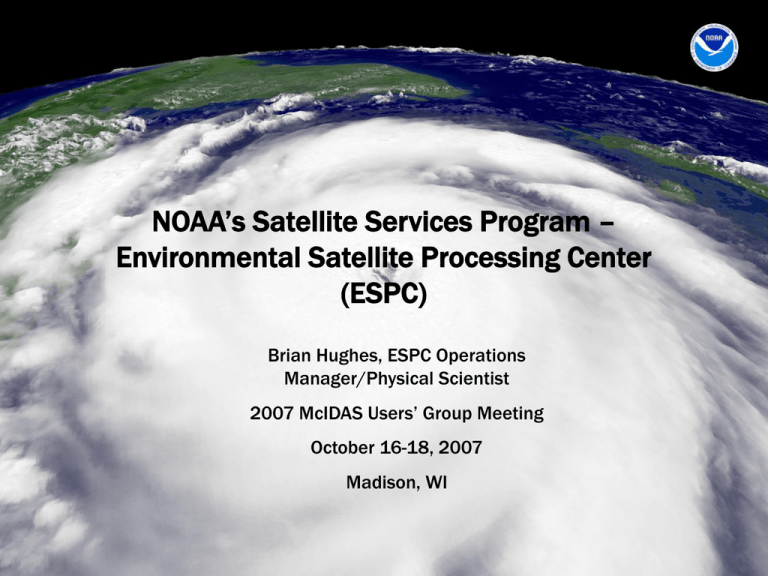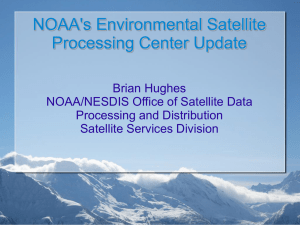NOAA’s Satellite Services Program – Environmental Satellite Processing Center (ESPC)
advertisement

NOAA’s Satellite Services Program – Environmental Satellite Processing Center (ESPC) Brian Hughes, ESPC Operations Manager/Physical Scientist 2007 McIDAS Users’ Group Meeting October 16-18, 2007 Madison, WI • ESPC was created in 2005 after the contracts for the Central EnvironMental Satellite Computer System (CEMSCS) and the SATellite Environmental Processing System (SATEPS) were merged together. • The NESDIS Office of Satellite Operations (OSO)/Data Processing and Distribution (OSDPD) manages the ESPC. • ESPC is headquartered at the NOAA Satellite Operations Facility (NSOF) in Suitland, MD and the NOAA Science Center/World Weather Building in Camp Springs, MD. NOAA-15, 16, 17, 18 MetOp-A NASA Terra, Aqua DoD DMSP MTSAT-1R (DOMSAT) MSG (landline via Wallops) Meteosat-7 (landline) GOES-11, 12 GOES-10 (H/S only) Various Ways Partners and Customers Public Polar Acquisition Stations for POES, MetOp, EOS - Wallops, VA - Fairbanks, AK - Gilmore Creek, AK - Svalbard - Honolulu, HI - Miami, FL - Australia - Monterey, CA - NASA DAACs Office of Satellite Operations (OSO) Office of Satellite Data Processing and Distribution (OSDPD) Satellite Operations User Services Product Generation Product Distribution STAR Services ESPC NPP, NPOESS, GOES-R…….. Office of Satellite Data Processing and Distribution (OSDPD) Information Processing Division Computer Operations (24x7 monitoring, Help Desk) Enterprise IT Architecture ESPC Contract Management Program Management Division Planning, Programming, Budget, and Execution System (PPBES) Satellite Services Division Products and Services User Services Interaction with STAR (R2O) Satellite Services Division (SSD) Serves as the primary interface between NOAA and our partners, customers, and users of NOAA’s operational satellite data products and services. These high quality products are either automated, human generated, or a man/machine mix and are distributed to users in a timely fashion. SSD also provides scientific expertise in the field of remotely sensed environmental applications, and works closely with the research community in the development of such products. SSD provides management of unique satellite based services such as Data Collection and Search and Rescue (SARSAT). Product Implementation Branch Satellite Analysis Branch Direct Services Branch Product Area Leads Hazard Analysis SARSAT Integrating Tools Satellite data and product verification Argos/DCS Product Development w/STAR Application Validation Interaction with NWS/NCEP Operational Development Direct Readout NOAASIS AWIPS Users (NOAAPort) GVAR ingest GOES Ingest/NOAAPort Interface (GINI) Environmental Applications McIDAS SDI Product Implementation Branch Satellite Analysis Branch McIDAS for automated processing and serving of satellite data and products McIDAS for interactive analyses and interpretive products, focused mission for hazards Interaction with STAR for product tailoring, updates, calibration, formats, etc. Product Oversight Panel (POP) Integrated Product Teams (IPT) SPE HMS Trop DT IMS TRaP Users OSEI VAA AODT GOES-12: East at 75° W GOES-11: West at 135° • 12 mm channel MTSAT-1R: Pacific at 140° E • Now HRIT Only via DOMSAT from Hawaii MSG-2: Europe/Africa at 0° GOES-13: On Orbit Spare at 105° W • 12 band SEVIRI Meteosat-7: Asia/India at 57° E GOES-10: South American Coverage at 60° W • H/S only FY-2C: backup/dev at 105° E Kalpana-1: backup/dev at 74° E METOP-A: AM Primary DMSP F-13 NASA Terra NOAA-18: PM Primary DMSP F-14 NASA Aqua NOAA-17: AM Backup DMSP F-15 SeaWIFS NOAA-16: PM Backup DMSP F-16 CORIOLIS/WindSat NOAA-15: AM Secondary Jason-2 GOES-O: April 08 • 4 km 13.3 mm GOES-P: April 09 GOES-R: 2014 • ABI, GLM, UPS GOES-S: 2016 • ABI, HES Jason-2: June 2008 NOAA-N’: Feb 09 NPP: September 2009 NPOESS C1: 2013 NPOESS C2: 2015 Successful GOES-13 launch May 24, 2006 New product initiatives including multiple output formats for diverse types of systems: GIS, N-AWIPS (VGF), Google Earth, among others. Analysis of Volcanic Ash from multiple sources converted into Google Earth (KML/KMZ) files Analysis of smoke converted into shapefile (for GIS) and VGF for N-AWIPS users SO2 products from OMI Development of the Ensemble Tropical Rainfall Potential (e-TRaP) Polar Microwave and Vis/IR composites in NOAAPort Multi-satellite 24h e-TRaP Stage IV analysis 18 UTC Sep 23 to 18 UTC Sep 24 2005 max 310mm 18 UTC Sep 23 to 18 UTC Sep 24 2005 LA LA max 320mm TX TX mm 0 1 2 4 6 8 12 inches Blended Total Precipitable Water (TPW) global view from AMSU, SSM/I, and GPS Satellite Analysis Branch collaborations with our research partners at STARCIMSS, NWS-NSSL, and NWS-NCEP SAB-CIMSS collaboration on Wind Divergence Algorithm SAB-CIMSS-NSSL collaboration on Dendridic Snow Growth Algorithm SAB-NCEP collaboration on synthetic satellite imagery from NWP radiances Future Endeavors: More blending of satellite sources, model, and in-situ data More automation of hazard (volcano, fires, ice, precip) signature detection through the use of multiple satellites, instruments, and observations: SO2, Infrasonics, Multispectral IR, ground and pilot observations, GOES/POES blending. Increased collaboration with the research community, especially with the increase in the number of instruments and channels available to users: NPP, GOES-R, NPOESS (leveraging off of the NDE, creating a “GDE”?) Increased outreach and training of partners and users, especially in light of new satellites, instruments, and products. Increased web based training: COMET, VISIT.






